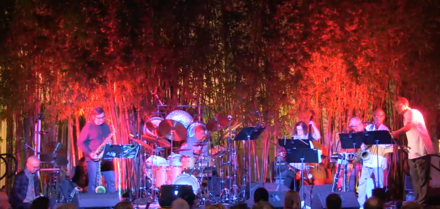Since we tend to forget how to breathe, we're lucky to have Alex Cline around for a reminder. A longtime Buddhist, Cline wanted to pay tribute to an inspiration, former collaborator and Buddhist priest, Art Ensemble of Chicago saxist Joseph Jarman, who died in January. So he carefully selected an ensemble of kindred spirits to play Jarman compositions. And as Gautama taught, they breathed.
Yes, the best jazz/improvisational music relies on group feel. But let's consider these musicians one at a time, just to appreciate how correctly Cline chose them.
G.E. Stinson, guitar. Though a Buddhist himself, Stinson is not all about quiet. His atonal FX strangulations distorted blues explosions on "Little Fox Run" and "Blues for Za Zen" (seated Zen, his specialty) delivered indispensable emotion, while his droning slides on "Eyes of the Charm Giver" emphasized the meditative side of Jarman's music. The Earth is no stranger to Stinson, who did substantial musical time in Chicago.
Phillip Greenlief, tenor and alto sax. Talk about breathing -- Greenlief's circular-breath technique means he can whip up a storm of condensed improvisation for extended periods without stopping. And he feels melody. And his lines always have logic. At one point he yanked the neck off his sax and blew such a multiphonic squall of sustain, somehow uniting with (I think) Stinson's noise, that it just about ripped our spleens.
George Abe, bamboo flutes. To hear his airy tones, you'd think Abe's breath wafts straight from a Shinto temple in Japan. But he was born in 1944 in Manzanar, California's WWII concentration camp. So his spirituality comes with an extra layer of transcendence.
Christopher Garcia, world drums and percussion. Garcia has deep roots in rock, but when L. Shankar wants Indian rhythms, he asks Christopher to fly east. Fusion, ancient Mesoamerican instruments, rarefied indigenous strings, Garcia approaches it all with equal practice and intuition. On this night, he tinkled bells, stroked tablas or crashed cymbals when he sensed a connection. Constant action.
Pablo Calogero, tenor sax, bass clarinet, flutes. Sometime when you've got a few hours, look up this guy's résumé, from Jaki Byard to Tito Puente to Carla Bley. On an occasion of so much variety, he was in regular demand, especially effective in the more open Coltrane-influenced segments. Total control.
Miguel Atwood-Ferguson, electric violin. You see this tall, serious composer-instrumentalist everywhere in town, fitting in with jazz, soul, avant, whatever. Like here! Loved him on the raga-like "Charm Giver."
Lisa Mezzacappa, upright bass. Also an ambitious composer, Mezzacappa actually books the Hammer's "JazzPOP" series, and Cline was fortunate to have her close at hand for this installment, where her big, aggressive sound and extended pinging/sliding techniques fit in perfectly.
Dwight Trible, vocals. Cline introduced him as "The Voice," and we could hear the capital T and V in the leader's enunciation. Trible's deep melismas have graced every kind of L.A. improvisation, and tonight we got to hear him actually sing the "Ommmmm" that resides unstated within everything he does.
Alex Cline, drums. Cline never lets you forget how important rock was to him as a kid, but he augments his insistent, bigfooted beat with sensual counter-rhythms and cymbal swirls, and when he solos, you're gonna be thrilled by every tinkle, ding, gong and clack in his usually huge kit. Elvin plus Tony plus Siddhartha.
Cline programmed Jarman's compositions (some of which he had performed with their author plus bassist Henry Grimes in 2003) for variety, from peaceful efflorescences to gutty rampages. Not only did he enlist a range of players who could cover the individual bases, he got players who could cover ALL the bases individually -- most of them had spotlights on every song. Is it possible for an audience to be boggled and pacified at the same time? Apparently so.
* * *
Don't take my word for it, watch the whole performance here. The music starts about 8 minutes in. Play it loud.

